|
|
|
Sort Order |
|
|
|
Items / Page
|
|
|
|
|
|
|
| Srl | Item |
| 1 |
ID:
167004
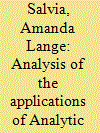

|
|
|
|
|
| Summary/Abstract |
In Brazil, the public lighting sector is a responsibility of the municipal government and typically represents around 4% of the electricity consumed by cities. Considering the significant importance and functions of this service, sustainable management is necessary. The aim of this paper is to investigate the main practices used worldwide in terms of energy efficiency of public lighting and propose the use of the multi-criteria method called Analytic Hierarchy Process to choose the best options for a group of Brazilian cities, namely Passo Fundo, Santa Maria and Porto Alegre. The methodology of this paper consists of searching for best practices in public lighting, which worked as alternatives for applying the Analytic Hierarchy Process. The final step consisted of presenting the impacts of a potential implementation, through analysis of energy and financial savings. The results suggest the preferred practices to each municipality (Audit and Guide Elaboration, Retrofit, Alternative Energy and Management) and their potential implementation can promote energy and financial savings up to 6 GWh/year and 600,000.00 US$/year. The main implications of this paper are related to proposing the use of a multi-criteria method to the public lighting sector and providing useful insights for local governments and especially for developing countries.
|
|
|
|
|
|
|
|
|
|
|
|
|
|
|
|
| 2 |
ID:
128339
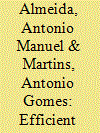

|
|
|
|
|
| Publication |
2014.
|
| Summary/Abstract |
The behavior of building designers is conditioned by the existing legislation and regulations in the national context in which they operate. However, in the Portuguese legislation there are no rules concerning the use of daylight, and therefore, designers are not stimulated to adopt solutions that make use of the existing potential of sunlight availability. In the same way, it is difficult to understand the lack of specific regulation, with quantified targets, limiting power density of artificial lighting installed inside buildings. The present opportunity, generated by the need to carry out the revision of Portuguese building energy systems regulation, should be used to fill the existing gap in national legislation regarding those matters. In this paper the authors present some proposals for future legislation that will have as central purpose the utilization of efficient lighting systems and the promotion of architectural solutions that optimize the use of daylighting. It is possible, and desirable, to add new directives to national legislation that contribute to the improvement of Portuguese buildings, characterized by its good performance in terms of daylight availability, and at the same time, increasing the energy efficiency and reducing the energy consumption of lighting systems installed in those buildings.
|
|
|
|
|
|
|
|
|
|
|
|
|
|
|
|
| 3 |
ID:
094286
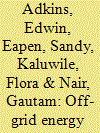

|
|
|
|
|
| Publication |
2010.
|
| Summary/Abstract |
Lanterns that use light-emitting diodes (LEDs) powered by batteries, which are in turn charged by grid electricity or small solar panels, have emerged as a cost-competitive alternative to kerosene and other fuel-based lighting technologies, offering brighter light for longer duration at equal or lower cost over time. This paper presents lessons learned from the introduction of solar LED lanterns in rural Malawi. We discuss a market-based program using new and existing local commercial structures such as vendors and cooperatives to sell lanterns to village households without subsidy. The paper addresses issues of enterprise development, community interactions, and survey data on lighting use and expenditure patterns before and after LED lantern introduction. Households that purchased a lantern reported high levels of satisfaction with the LED lanterns as well as savings in annual kerosene expenditure comparable to the price of the lantern. These households also reported monthly incomes comparable to the price of the LED lanterns whereas non-adopters surveyed reported monthly incomes about half this level, suggesting a need for financing options to maximize adoption among poorer populations in rural areas. These results suggest that similar market based models of LED lighting technology dissemination have the potential to be replicated and scaled up in other off-grid regions in developing countries. However, viability of local cooperatives and supply chains for lantern products over the medium-to-long term remain to be assessed.
|
|
|
|
|
|
|
|
|
|
|
|
|
|
|
|
| 4 |
ID:
094394
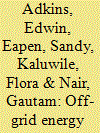

|
|
|
|
|
| Publication |
2010.
|
| Summary/Abstract |
Lanterns that use light-emitting diodes (LEDs) powered by batteries, which are in turn charged by grid electricity or small solar panels, have emerged as a cost-competitive alternative to kerosene and other fuel-based lighting technologies, offering brighter light for longer duration at equal or lower cost over time. This paper presents lessons learned from the introduction of solar LED lanterns in rural Malawi. We discuss a market-based program using new and existing local commercial structures such as vendors and cooperatives to sell lanterns to village households without subsidy. The paper addresses issues of enterprise development, community interactions, and survey data on lighting use and expenditure patterns before and after LED lantern introduction. Households that purchased a lantern reported high levels of satisfaction with the LED lanterns as well as savings in annual kerosene expenditure comparable to the price of the lantern. These households also reported monthly incomes comparable to the price of the LED lanterns whereas non-adopters surveyed reported monthly incomes about half this level, suggesting a need for financing options to maximize adoption among poorer populations in rural areas. These results suggest that similar market based models of LED lighting technology dissemination have the potential to be replicated and scaled up in other off-grid regions in developing countries. However, viability of local cooperatives and supply chains for lantern products over the medium-to-long term remain to be assessed.
|
|
|
|
|
|
|
|
|
|
|
|
|
|
|
|
| 5 |
ID:
115673
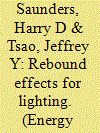

|
|
|
|
|
| Publication |
2012.
|
| Summary/Abstract |
In this Communication, we seek to clarify confusion regarding our 2010 Journal of Physics article on historical rebound effects for lighting, which showed that global energy use for lighting has experienced 100% rebound over 300 years, six continents, and five technologies. We argue that our results have been misunderstood by some to mean lighting efficiency gains are counterproductive, and we instead argue for vigorously promoting improved lighting technologies.
|
|
|
|
|
|
|
|
|
|
|
|
|
|
|
|
| 6 |
ID:
150647
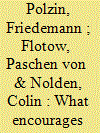

|
|
|
|
|
| Summary/Abstract |
Municipalities aiming at mitigating climate change by implementing new energy efficiency technologies face budgetary and capacity constraints. Outsourcing through energy service contracting could provide a solution. This paper reports results from a survey of 1298 municipalities concerning barriers to retrofitting public street lighting and the possible role of energy service contracting to overcome these barriers. Using a logistic regression analysis, the authors investigate determinants of opting for energy service contracts in the specific context of LED retrofits. Results point to an advantage of outsourcing in a financially and capacity-constrained environment, which corresponds with the main reasons for engaging in contracting: minimising investments and financial risks. However, municipalities often do not fully grasp the risks associated with retrofitting especially using a novel technology such as LED. In relation to that they underestimate the risk reduction potential of energy performance contracts (EPC). Previous experience with outsourcing increases the probability to engage in servitization although certain existing partnerships, particularly with utilities, prevent municipalities from considering energy performance contracts. Interestingly, engaging an energy consultant has a negative propensity to use energy service contracts, while pre-negotiated standardised contracts for energy performance contracts have a positive influence.
|
|
|
|
|
|
|
|
|
|
|
|
|
|
|
|
|
|
|
|
|